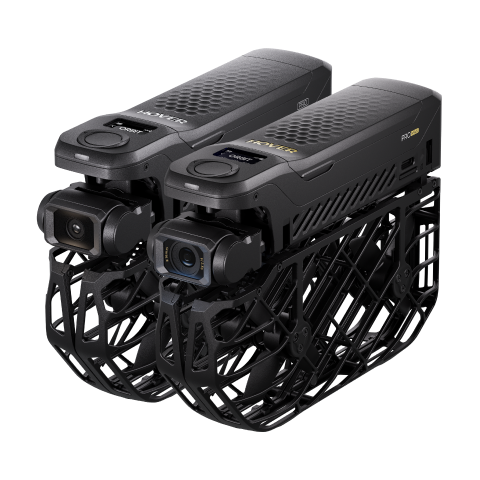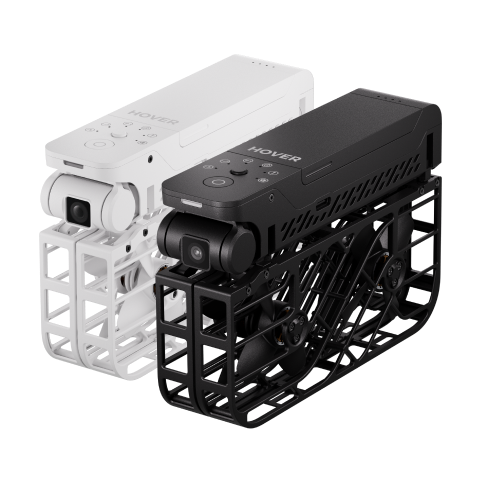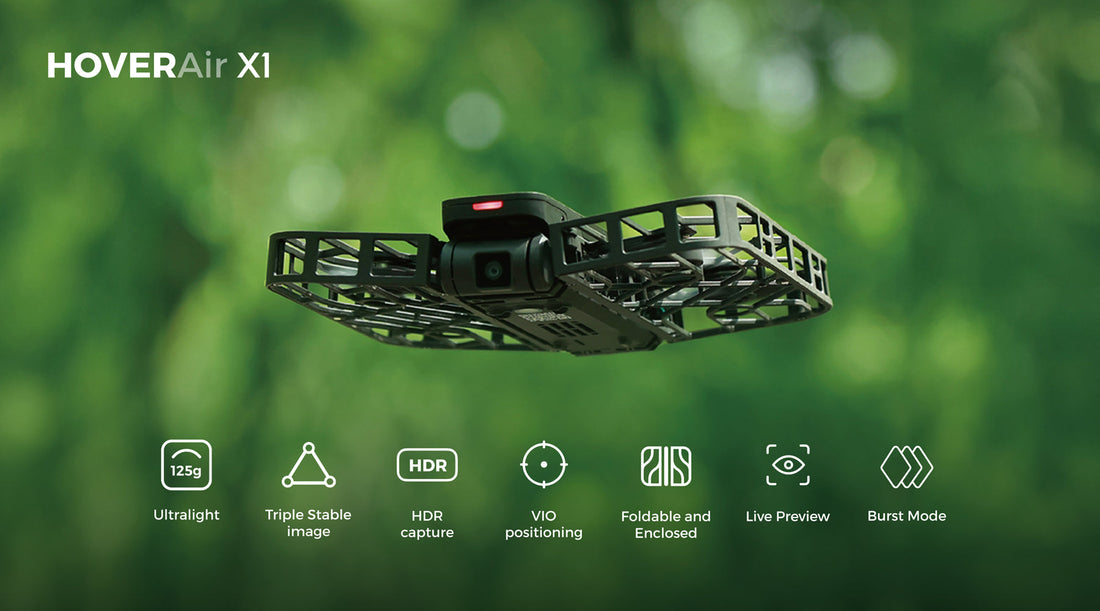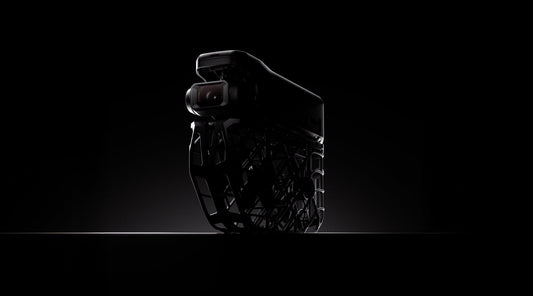Despite limited manual flight capabilities, the HOVERAir X1 is designed to capture footage of the user and/or people nearby using intelligent tracking algorithms. This small and lightweight drone features built-in propeller guards for increased safety and can take off and land directly from the palm of your hand. The HOVERAir X1 is incredibly simple and intuitive to operate, offering 2.7K video resolution at up to 30 frames per second or 12-megapixel photos.
In our latest review, we take a closer look at the HOVERAir X1, an entry-level drone from Zero Zero Robotics that stands out primarily for its user-friendly operation and advanced technology. Designed as an autonomous selfie drone, the HOVERAir X1 offers exciting features thanks to its intelligent tracking algorithms, capable of following both static and moving subjects. The drone promises to be ready to fly within seconds and focuses on tracking the user, making it particularly attractive for selfies and vlogging.
Our test focuses on evaluating the camera performance, which captures video at up to 2.7K resolution at 30 fps. While the HOVERAir X1 is not necessarily intended for professional use, it is an ideal choice for content creators who regularly shoot videos of themselves. We also examine the drone’s ease of use, safety features, and overall performance in various conditions. In particular, we assess how well it fulfills its primary task—user tracking—and how well it meets the needs of beginners in drone photography and videography. In addition to technical details and controls, our review also addresses the limitations of manual operation and evaluates how these affect the overall experience. With this comprehensive approach, we aim to determine whether the HOVERAir X1 can be considered one of the best beginner drones and which niche it best fills in the growing drone market.

The HoverAir X1 from the Chinese manufacturer Zero Zero Robotics is an exciting and innovative product — it is an easy-to-use camera drone that can be perfectly described as a flying selfie stick. The HoverAir X1 is incredibly simple to operate, safe, and above all, a lot of fun. Additionally, it does an impressively good job when autonomously tracking subjects.
HOVERAir X1: Small, Lightweight, and Available in Black or White
Weighing just 125 grams including the battery, the HOVERAir X1 is among the lightest drones on the market. The propellers are safely enclosed within a plastic protective cage to minimize damage in the event of a collision and reduce the risk of injury. Interestingly, the two foldable cages are gear-linked, ensuring synchronized and even unfolding on both sides. When folded, two small magnets keep the drone securely closed.
The drone impresses not only with its sleek and lightweight design and foldability but also with its appealing and high-quality build. The battery clicks into place at the center of the drone, around which you’ll find various control elements such as the power/take-off button, mode selection button, status indicator, and battery level display.

The HOVERAir X1 records video in 2.7K resolution (2,704 × 1,520p) to an internal 32GB memory. In addition to 2.7K at 30 fps, it supports Full HD recording at up to 60 fps. Since the drone lacks a memory card slot, footage must be transferred to the HOVERAir app for further editing. The drone reaches top speeds of up to 7 m/s (about 25 km/h), making it well-suited for capturing footage while jogging, snowboarding, or cycling. When folded, the drone measures only 127 × 86 × 31 mm, making it highly portable. Unfolded, its dimensions are 127 × 145 × 30 mm. Weighing under 250 grams, it qualifies as a C0 drone under EU drone regulations, meaning it can be operated without a drone license and without a mandatory minimum distance from people. More information on drone classes is available [here].
Due to its weight of less than 250 grams, the legal requirements for using the HOVERAir X1 are relatively simple. Classified as a C0 drone under EU regulations, it falls into the most accessible category in terms of requirements, rights, and obligations. This means no drone license is needed, and the drone can be flown close to people. However, it’s important to comply with legal requirements such as drone registration and attaching an EU drone identification label. Liability insurance is also required for legal operation. You can find more details in our article on EU drone regulations.
The HOVERAir X1 is available in white or black, with the battery color matching the drone. When purchasing a spare battery, make sure it matches the color variant of your drone. The HOVERAir X1 is available on the manufacturer’s website for €469 (MSRP). For an additional €70, a combo set is available for €539, which includes a second battery and a multi-charger. lternatively, the Combo Plus package (€579) includes three batteries. With a tested indoor flight time of 10 minutes per charge, one of the combo sets is recommended for frequent use.
Controls and Recording Modes of the HOVERAir X1
The HOVERAir X1 stands out for its simple and intuitive operation. The drone features just two physical buttons on the frame: a power/take-off button and a mode selection button. Once activated via the app, it can be used without a smartphone for quick recordings. Videos and photos are saved to the internal 32GB memory and can be transferred to a

Autonomous Flight Modes, Intelligent Navigation, and Tracking
The HOVERAir X1 is primarily designed for autonomous flight and offers a range of intelligent flight modes that make it easier to capture stable video. These include Hover, Follow, Orbit, Zoom Out, Bird’s Eye, Dolly Track, and Snapshot.
By activating the “Hover” function, the HoverAir X1 takes off and holds its position while keeping the user in focus. In “Zoom Out” mode, the selfie drone gradually moves away and gains altitude. The “Follow” mode allows the X1 to follow the user, even during faster movements such as running or cycling. To create a circling motion around the user, the “Orbit” mode can be used. The “Bird’s Eye” mode lets the drone ascend to capture footage from a top-down perspective. For continuous forward shots, there’s also the “Dolly Track” mode. If you want the drone to hover in place and take a photo as soon as you strike a pose, you can select the “Snapshot” mode.

To land the drone, simply hold out your hand while standing still. The HOVERAir X1 also features a manual mode, allowing control via the smartphone app using virtual joysticks. Experienced pilots will adapt quickly, and the app provides a live camera feed.
These intelligent flight modes work exceptionally well thanks to a visual positioning system based on infrared and camera sensors. While effective, this system does not include obstacle avoidance, so caution is needed near trees or other objects. However, the HOVERAir X1 navigated complex environments impressively well during our tests. Unlike many drones, the HOVERAir X1 does not rely on GPS/GNSS for positioning, meaning no GPS signal is required. As a result, features like "Return to Home" are unavailable. But given the drone's limited flight range, this is rarely an issue. If the battery is low, the drone lands safely and autonomously at its current location. The HOVERAir X1 excels at subject tracking. It uses its main camera to keep individuals or groups centered in the frame with impressive accuracy. A notable feature is its ability to quickly reacquire a lost subject. This rapid re-identification greatly enhances the user experience. The intelligent functions—including subject tracking and stabilization—are powered by three main sensors: the front-facing camera for object detection, a downward camera for hovering, and an infrared sensor to measure altitude from the ground or hand.
Customization and App Control
Some parameters of the intelligent flight modes, such as distance from the subject or flight altitude, can be individually adjusted; however, there are no options for more advanced settings. Custom modes must be configured within the app, and the most recently used custom mode remains active until it is changed in the app.
Manual control and downloading of photos and videos require a WiFi connection to the HoverAir X1, which usually only takes a few seconds to establish. During testing, there were no connection issues when flying manually or downloading media. The app is available for both Android and iOS and features a simple, intuitive interface—often supported by helpful tips and tutorial videos.
Manual Flight Characteristics
Manual control via the app is generally sufficient, though the layout could be improved. Some commands—like flying forward while rolling—are difficult to combine. Manual flight is limited to 30 seconds with a transmission range of up to 30 meters. The maximum flight altitude is 15 meters. Although wind resistance is relatively low (about 28 km/h), electronic image stabilization ensures smooth footage even in breezy conditions. However, stronger winds may cause noticeable shake.
Camera Quality and Recording Features
The HOVERAir X1 offers not only ease of use but also diverse camera functions. Though specific image sensor details are undisclosed, the camera records in 2.7K resolution—more than sufficient for social platforms like TikTok, Instagram, and Facebook.
Image Stabilization and Video Quality
A key feature is its effective electronic image stabilization (EIS), delivering smooth, professional-looking footage. The drone records in 2.7K at 30 fps and Full HD at 60 fps, allowing slow-motion playback. The EIS combined with a single-axis gimbal keeps footage stable. While it lacks a full 3-axis gimbal, the camera can tilt from -90° to 15°, enabling flexible shooting angles, including overhead shots. Because of its compact size, a traditional 3-axis gimbal is absent. Nonetheless, the tilt range is sufficient for most shooting needs.

For best results, use the drone in windless conditions, as even light breezes can affect stability. In calm weather, it flies smoothly and captures clean, stable footage. Videos and photos are stored on internal memory, while the app shows only a low-res preview. Files can be transferred via Wi-Fi to iOS or Android devices.
Camera Technology and Shooting Modes
The HOVERAir X1 likely uses a 1/2.3-inch CMOS sensor with a native resolution of 12MP. Its fixed-aperture f/2.4 lens with a 2.5 mm focal length is well-suited to various shooting scenarios. In addition to standard video, the drone offers an HDR mode (1080p) for improved image quality in challenging lighting. It also supports vertical video recording (1080p at 30 fps), ideal for social media.
Adaptability and User Experience
Users can customize the video mode for each flight via the app, providing great flexibility. The photo function includes single and burst modes, with images saved in JPEG format. Videos are encoded in H.264 (AVC) for efficient compression with good quality.
Lighting Conditions and Image Processing
The HOVERAir X1 delivers its best image quality under good lighting conditions, thanks to its electronic image stabilization and relatively small image sensor. In low-light situations, however, image noise becomes more noticeable—also due to the small sensor. The camera offers only three preset modes, which limits manual control options somewhat.

Nevertheless, the sharpness and exposure provided by the HOVERAir X1 are more than sufficient, even in challenging lighting conditions such as backlighting. It's also noticeable that both sharpness and exposure are optimized through internal algorithms, for example, to ensure that the faces of people filmed by the drone are portrayed in a particularly flattering way. In this regard, the HOVERAir X1 is more comparable to modern smartphones, which also use advanced processing techniques to enhance image quality. Nevertheless, the HOVERAir X1 is excellent for capturing footage at larger events or while traveling, where it can be effectively used either in groups or solo as a "flying cameraman."
Note on the EU Drone Regulation:
When it comes to the 2021 EU Drone Regulation, the HOVERAir X1 is a future-proof investment. Thanks to its low weight of under 250 grams, the drone falls under the C0 classification and is subject to virtually no restrictions. However, pilot registration and an EU drone identification label are still required for the HOVERAir X1. We've summarized all the requirements of the EU Drone Regulation here: [Information on the EU Drone Regulation] Important Tip: Drone insurance is legally required even for the HOVERAir X1! See our drone insurance comparison: [Link]
Conclusion and Review of the HOVERAir X1
Pros
The HOVERAir X1 is revolutionizing the camera drone market with its simple operation and compact design. This drone is ideal for people who may never have previously considered buying a camera drone. Its portable size makes it especially suitable for use indoors or in confined spaces.
The HOVERAir X1 stands out for its ability to deliver professional-quality footage without the need for calibration, GPS connection, or a bulky remote control. This means no prior experience is necessary—just unpack, unfold, and start flying. With its compact dimensions, the drone fits into nearly any bag, making it the perfect travel companion. Whether for everyday use or on vacation, the HOVERAir X1 is always ready to go. One key feature is the extremely simplified control concept, which works completely without a traditional controller and, if desired, even without a smartphone. In practice, this concept has proven to be surprisingly effective.
With a retail price starting at €469, the HOVERAir X1 offers good value for a specific target audience that falls somewhere between social media enthusiasts and drone beginners. The HOVERAir X1 feels like a gadget from the future—and it's exciting to see what Zero Zero Robotics will come up with next.

Cons
Despite its many advantages, the HOVERAir X1 also has a few drawbacks. The internal storage is limited to just 32 gigabytes, with no slot for a microSD card, which restricts overall capacity. The flight time is relatively short at around 10 minutes, limiting how long it can be used at a time. Additionally, while the €469 price tag is fair considering its features, it is relatively high compared to competing models such as the DJI Mini 4K or the DJI Mini 2 SE, which offer more features and better resolution at a lower price. Overall, the HOVERAir X1 is an impressive drone for beginners and social media fans who value ease of use and portability above all.

The Original source from: https://www.drohnen.de/50853/hoverair-x1-test/















